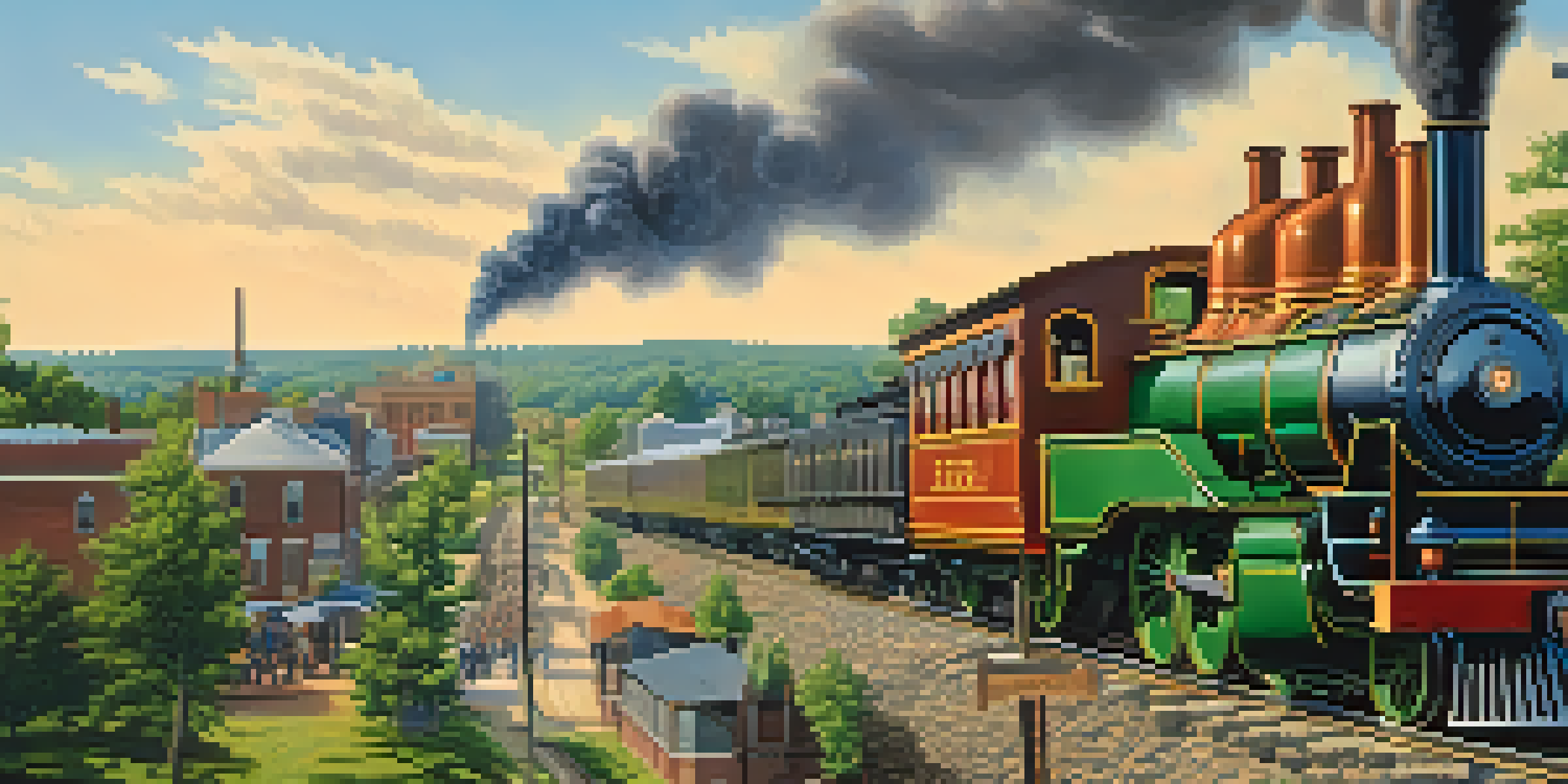The Birth of Railroads: Charlotte's Transportation Revolution

The Early Days: A Growing Need for Transportation
In the early 19th century, Charlotte was evolving from a small trading post into a bustling hub. The demand for efficient transportation links intensified as trade flourished, and local businesses sought better ways to move goods. Horse-drawn carriages were simply not cutting it anymore, and the vision for a more powerful solution began to take shape.
The railroad is a great civilizer. It brings the markets to the farmer, and the farmer to the markets.
As the town's population grew, so did the need for a reliable transport system. The idea of railroads emerged as a promising alternative, offering speed and efficiency that horse-drawn transport could never match. This burgeoning interest was not just about convenience; it was about connecting communities and fostering economic growth.
Local leaders and entrepreneurs began to see the potential of railroads to reshape Charlotte’s economy. The vision of iron tracks stretching into the countryside sparked excitement, as residents imagined the possibilities that awaited them with improved access to markets and resources.
The First Railroad: The Charlotte and South Carolina Railroad
In 1852, the first railroad line, the Charlotte and South Carolina Railroad, was completed, marking a significant milestone. This line connected Charlotte to Columbia, South Carolina, opening up new avenues for trade and travel. The success of this venture was a testament to the growing confidence in railroads as a transformative force.

The arrival of the railroad not only facilitated the movement of goods but also attracted new businesses and settlers to the area. It became easier for farmers to transport their crops to markets, and local industries saw a surge in production. Charlotte was quickly becoming a vital link in the transportation network of the Southeast.
Railroads Transformed Commerce
The introduction of railroads revolutionized trade in Charlotte, enabling quick and efficient shipping that boosted local industries and attracted new businesses.
Moreover, the railroad brought with it a cultural shift, encouraging travel and tourism. Families could now visit relatives in neighboring towns, and merchants could expand their businesses beyond local confines. The railroad was not just a means of transportation; it was a catalyst for community growth and connection.
Economic Impact: Boosting Trade and Commerce
The introduction of railroads had a profound impact on Charlotte's economy. With the ability to ship goods quickly and efficiently, local industries flourished. Farmers could send their produce to distant markets, and manufacturers could easily acquire raw materials, leading to increased production and profits.
The railroads are a great factor in the development of the country.
As trade routes expanded, so did the job market. New opportunities emerged as businesses sought workers to meet the demands of increased production and shipping. This influx of jobs attracted a diverse population, bringing new skills and ideas that contributed to Charlotte's economic dynamism.
Additionally, the ease of transportation allowed for the growth of related industries, such as shipping and warehousing. These developments created a ripple effect, boosting the overall prosperity of the region and solidifying Charlotte's status as a key economic player in the South.
Social Changes: Connecting Communities
The railroad revolutionized not just commerce but also social interactions in Charlotte. Families could now visit loved ones in neighboring towns with relative ease, fostering stronger community ties. This newfound accessibility helped to bridge gaps between rural and urban areas, creating a more interconnected society.
Moreover, the railroads enabled cultural exchanges that enriched the community. People from different backgrounds could share their traditions, ideas, and lifestyles, leading to a vibrant, diverse cultural landscape. Events such as fairs and festivals became more common, drawing crowds from afar and fostering a sense of unity.
Social Connectivity Increased
Railroads not only facilitated commerce but also strengthened community ties by making it easier for families to connect and share cultural experiences.
As the railroads transformed transportation, they also transformed the way people lived and interacted. The social fabric of Charlotte began to interweave in ways that would shape its identity for generations to come.
Challenges and Setbacks: Overcoming Obstacles
Despite the overwhelming benefits of railroads, the journey was not without its challenges. Early railroad construction faced numerous obstacles, including financial difficulties and political opposition. Securing funds and land for tracks often proved to be a daunting task for railroad companies.
Additionally, the Civil War brought further disruption to the railroad expansion efforts. Many railroads were damaged or destroyed during the conflict, and resources became scarce. The post-war period was marked by a struggle to rebuild and restore the infrastructure that had been so vital to Charlotte's growth.
However, the resilience of the community shone through these challenges. Local leaders rallied support for rebuilding efforts, and the determination to see the railroads thrive never waned. This period of hardship ultimately laid the groundwork for a more robust and expansive railroad system in the years to come.
Technological Advancements: Innovation in Railroads
The evolution of railroads in Charlotte was closely tied to technological advancements in the industry. As rail technology improved, trains became faster and more reliable, further enhancing their appeal. Innovations such as steam locomotives revolutionized the speed and efficiency of transport, allowing for greater distances to be covered in shorter times.
The introduction of new materials, such as steel for tracks, also played a crucial role in the expansion of the railroads. These advancements not only improved safety but also enabled heavier loads to be transported, which was essential for the growing demands of commerce.
Resilience Amid Challenges
Charlotte faced numerous obstacles in railroad expansion, yet the community's determination and resilience ultimately led to a robust transportation network.
Moreover, the development of signaling systems and better train scheduling ensured smoother operations. As trains moved more reliably and efficiently, Charlotte's railroads became a model for other cities, showcasing the incredible potential of rail transportation in fostering economic and social growth.
Legacy of Railroads: Shaping Charlotte's Future
The impact of railroads on Charlotte's development is still felt today. The transportation infrastructure laid during the railroad revolution paved the way for modern transit systems, including highways and air travel. Charlotte's status as a transportation hub continues to thrive, with its bustling airport and extensive road networks.
Moreover, the cultural shifts initiated by the railroads have left a lasting legacy. The interconnectedness fostered by rail travel remains a cornerstone of Charlotte’s identity, promoting community engagement and cultural exchange. The city's diverse population continues to thrive, rooted in the spirit of connection that railroads first brought to the region.

As we look back on the birth of railroads in Charlotte, it’s clear that this transportation revolution was about more than just trains on tracks. It was about building a community, fostering economic growth, and creating a legacy that would shape the future of this vibrant city.